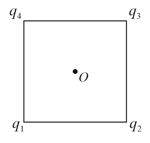EASY
NEET
IMPORTANT
Earn 100
Draw the equipotential surface for (a) a dipole and (b) two identical negative charges placed at a certain distance apart.

Important Questions on Electrostatic Potential and Capacitance
MEDIUM
NEET
IMPORTANT
Three identical charges are arranged at the corners of an equilateral triangle of side a and a charge brought to the centre of the triangle, the three charges being held fixed at its corners. How much extra work is needed to this?
EASY
NEET
IMPORTANT
Derive an expression of stored potential energy, when a dipole rotated from stable equilibrium position to any position in an external uniform electric field.
HARD
NEET
IMPORTANT
An electric dipole of dipole moment is placed along the axis of a right angled cone such that the vertex of cone is at the centre of dipole. If the semi vertex angle of cone is and slant height of curved surface is , then find the electrostatic potential at any point of circumference of base of cone
MEDIUM
NEET
IMPORTANT
"Inside a conductor, electrostatic field is zero", why?
HARD
NEET
IMPORTANT
A slab of material of dielectric constant has the same area as the plates of a parallel-plate capacitor but has a thickness , where is the plate separation. How is the capacitance changed when the slab is inserted between the plates?
EASY
NEET
IMPORTANT
A network of three capacitors is connected to a supply, as shown in fig. Determine the charge on each capacitor.

EASY
NEET
IMPORTANT
Graphs for two capacitors of capacitances and are shown in figure. The area of plates for both capacitors are same but separation between plates is double for to that of . Which of the graph corresponds to , and and why?

MEDIUM
NEET
IMPORTANT
(i) In the given figure, there are four point charges placed at the vertex of a square of side . If , and , then find the electric potential at the centre of the square, assume the potential to be zero at infinity.

(ii) An electric field exists in the space. If potential at the origin is taken to be volt, then find the potential at .
